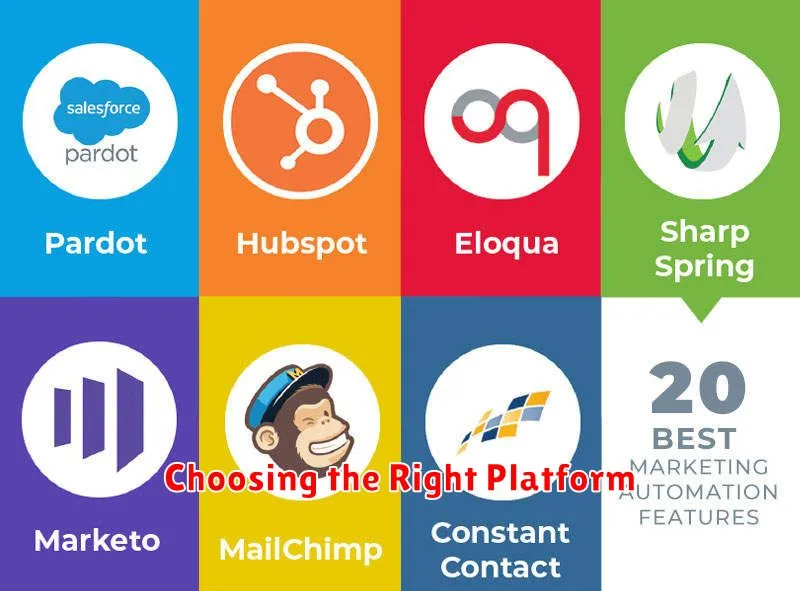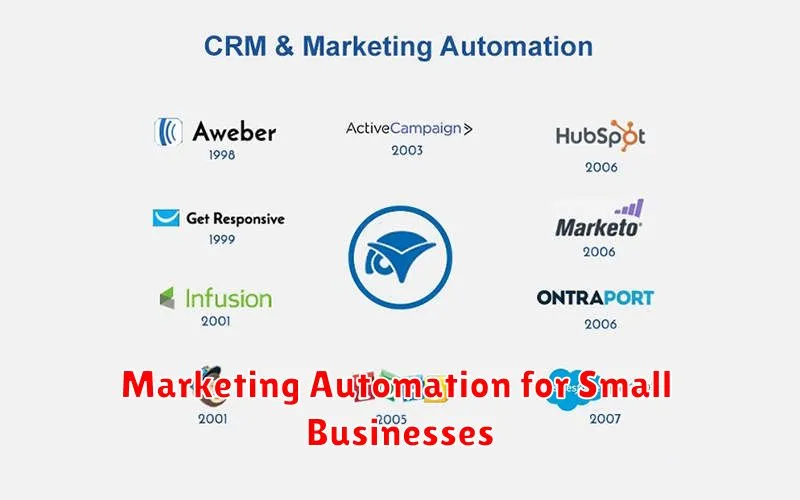Marketing automation can revolutionize how small businesses operate. In today’s competitive landscape, efficiently managing marketing efforts is crucial for growth. Small businesses often face limited resources and time constraints, making it challenging to compete with larger enterprises. Marketing automation offers a solution by streamlining repetitive tasks, optimizing marketing campaigns, and nurturing leads effectively. Learn how marketing automation for small businesses can be a game-changer, enabling you to achieve significant results with fewer resources and a more targeted approach.
This article will explore the key benefits of implementing marketing automation for small businesses. We’ll delve into how automation can enhance your marketing strategies, improve customer engagement, and ultimately drive business growth. Discover the power of marketing automation to personalize customer journeys, generate qualified leads, and boost your return on investment (ROI). Whether you’re a startup or an established small business, understanding and implementing marketing automation can be the key to achieving sustainable success.
What Is Marketing Automation?
Marketing automation is the use of software to automate repetitive marketing tasks. This allows businesses to nurture prospects with personalized content, improving efficiency and generating more leads.
Key benefits of marketing automation include saving time and resources, increasing conversion rates, and providing valuable data insights into customer behavior.
Typical tasks that can be automated include email marketing campaigns, social media posting, and lead nurturing workflows. This automation ensures consistent messaging and personalized experiences for potential customers.
Through pre-defined workflows, marketing automation platforms trigger actions based on specific criteria. For example, a customer abandoning their online shopping cart might automatically receive a reminder email with a special offer.
By automating these processes, businesses can focus their efforts on strategic marketing initiatives, ultimately leading to improved ROI and business growth.
Benefits for Small Business Owners
Marketing automation offers numerous advantages for small business owners. It allows for efficient lead nurturing, guiding potential customers through the sales funnel with automated email sequences and personalized content. This personalized approach helps build stronger customer relationships, increasing engagement and brand loyalty.
Time-saving automation of repetitive tasks like social media posting and email marketing frees up valuable time for owners to focus on strategic initiatives. This increased efficiency translates to reduced marketing costs by optimizing resource allocation and minimizing manual effort.
Improved lead conversion rates are another key benefit. By targeting the right audience with personalized messaging and automated follow-ups, businesses can effectively move leads through the sales process and increase conversions. Furthermore, detailed analytics and reporting provided by automation platforms offer valuable insights into campaign performance, allowing for data-driven decision-making and continuous improvement of marketing strategies.
Choosing the Right Platform

Selecting the right marketing automation platform is crucial for small businesses. Several factors should influence your decision. Budget is a primary concern. Platforms range from free options with limited features to enterprise-level solutions with hefty price tags. Identify your must-have features and prioritize accordingly.
Ease of use is another key consideration. A platform with an intuitive interface and straightforward setup will allow your team to quickly get up and running. Consider the level of technical expertise within your organization. Some platforms require more technical knowledge than others. Scalability is also important. Choose a platform that can grow with your business. While your needs may be modest now, consider your future marketing automation requirements.
Finally, integration with existing systems is vital. Ensure the platform seamlessly connects with your CRM, email marketing software, and other essential tools. This integration will streamline your workflows and maximize efficiency.
Setting Up Your First Workflow
Setting up your first marketing automation workflow can seem daunting, but it doesn’t have to be. Start by identifying a key marketing goal. Do you want to nurture leads, welcome new subscribers, or recover abandoned carts? Choosing a specific goal will guide your workflow design.
Next, define your target audience for this workflow. Who are you trying to reach? Understanding your audience will help you tailor your messaging and offers effectively.
Then, map out the steps in your workflow. This typically involves a trigger (e.g., subscribing to a newsletter), followed by a series of actions (e.g., sending a welcome email, offering a discount). Consider using a visual workflow builder to simplify this process.
Test your workflow thoroughly before launching it. Check for errors in automation logic, email content, and personalization. A small test group can provide valuable feedback and help you identify any necessary adjustments.
Automated Email Sequences
Automated email sequences are a cornerstone of effective marketing automation. They allow you to send a series of targeted emails to specific segments of your audience, nurturing leads and building relationships over time. This removes the need for manual email sends, freeing up your time for other essential tasks.
Consider using automated email sequences for various purposes, such as welcome series for new subscribers, post-purchase follow-ups, abandoned cart reminders, and product promotion campaigns. Each sequence should have a clear objective and provide valuable content to the recipient.
Key benefits of using automated email sequences include increased engagement, improved conversion rates, and enhanced customer loyalty. By providing timely and relevant information, you can guide your audience through the sales funnel and ultimately drive business growth.
Lead Scoring and Qualification
Lead scoring and qualification are crucial aspects of marketing automation. Lead scoring assigns numerical values to leads based on their engagement and characteristics. This helps prioritize leads most likely to convert into customers. Factors considered can include website activity, email interactions, demographic information, and company size.
Lead qualification determines whether a lead fits your ideal customer profile (ICP). It involves assessing their needs, budget, and authority to make purchasing decisions. Automating this process through marketing automation software saves time and resources, allowing sales teams to focus on high-potential leads.
By combining lead scoring and qualification, businesses can streamline their sales pipeline. High-scoring, qualified leads are passed directly to sales, while lower-scoring leads might receive further nurturing through targeted email campaigns or other marketing efforts. This targeted approach improves efficiency and increases the likelihood of converting leads into customers.
Tracking and Reporting Automation
Tracking and reporting are crucial aspects of marketing automation. Automated systems can track various metrics, providing valuable insights into campaign performance and customer behavior. This data-driven approach enables businesses to make informed decisions and optimize their marketing strategies for better results.
Key metrics often tracked include website traffic, lead generation, conversion rates, and customer lifetime value. By automating the collection and analysis of this data, businesses can save significant time and resources while gaining a deeper understanding of their target audience.
Automated reporting tools can generate visually appealing dashboards and reports, summarizing key performance indicators (KPIs) and highlighting trends. This allows marketers to easily monitor progress, identify areas for improvement, and demonstrate the return on investment (ROI) of their marketing efforts.
Common Mistakes to Avoid
Implementing marketing automation can be transformative, but it’s important to avoid common pitfalls. One frequent mistake is lack of a clear strategy. Businesses sometimes jump into automation without defining specific goals and how automation will help achieve them. This often leads to wasted resources and disappointing results.
Another significant error is over-automating communication. While efficiency is a key benefit, bombarding customers with irrelevant or overly frequent messages can be detrimental. This can damage your brand image and lead to unsubscribes or even customer churn.
Ignoring data analysis is also a common mistake. Marketing automation generates valuable data about customer behavior and campaign performance. Failing to analyze this data means missing opportunities to refine strategies and optimize campaigns for better results. Regular review and adjustments are crucial for success.
Finally, businesses sometimes neglect the human element. Automation should complement, not replace, personal interaction. Striking a balance between automated messaging and personalized engagement is essential for fostering strong customer relationships.
Integrating with CRM Tools
Integrating your marketing automation platform with your Customer Relationship Management (CRM) system is crucial for maximizing efficiency and gaining a holistic view of your customer interactions. This integration allows for seamless data flow between marketing and sales, enabling more targeted and personalized campaigns.
By connecting these systems, valuable data such as lead scores, website activity, and email engagement can be automatically synced to your CRM. This empowers sales teams with real-time insights into prospect behavior, allowing them to prioritize leads, personalize outreach, and ultimately close deals faster.
Furthermore, CRM integration enables closed-loop reporting. By tracking the entire customer journey from initial contact to final sale, businesses can accurately measure the effectiveness of their marketing efforts and optimize campaigns for better ROI. This integration eliminates manual data entry, reducing errors and freeing up valuable time for both marketing and sales teams to focus on revenue-generating activities.
Best Practices for Sustainable Growth
Implementing marketing automation effectively requires a focus on sustainable growth. This means building processes that not only yield immediate results but also contribute to long-term success. Data-driven decision making is paramount. Regularly analyze campaign performance metrics, such as open rates, click-through rates, and conversion rates. This data informs necessary adjustments to your automated workflows, ensuring continuous improvement.
Segmentation plays a crucial role in sustainable growth. By dividing your audience into distinct groups based on shared characteristics, you can tailor automated messages to their specific needs and interests. This personalized approach fosters stronger engagement and improves the effectiveness of your campaigns.
Testing and optimization are essential for long-term success. A/B test different versions of your automated emails and landing pages to determine what resonates best with your target audience. Continuously refine your strategies based on the results to maximize conversions and ROI.
Finally, maintaining a customer-centric approach is vital. While automation streamlines processes, remember to prioritize the customer experience. Ensure your automated messages are relevant, helpful, and timely. Actively solicit feedback and be responsive to customer inquiries to build strong, lasting relationships.

